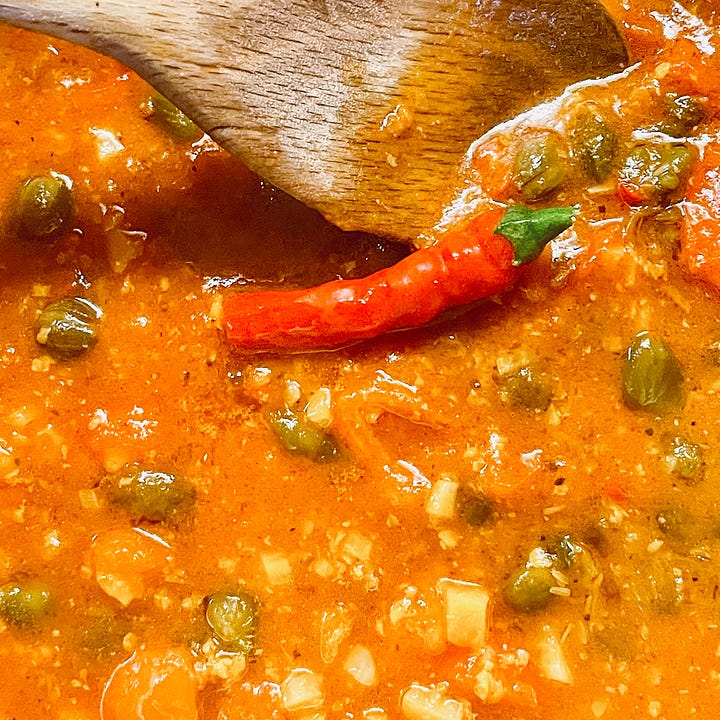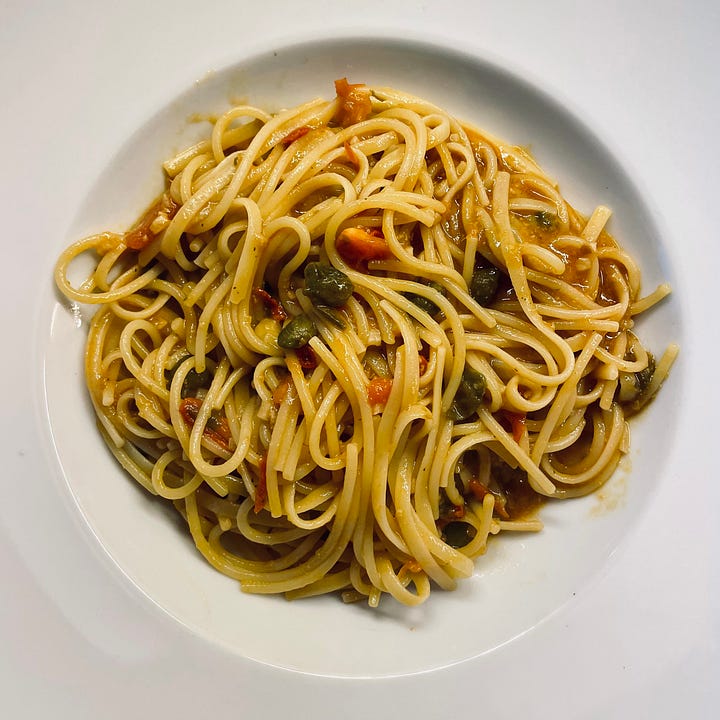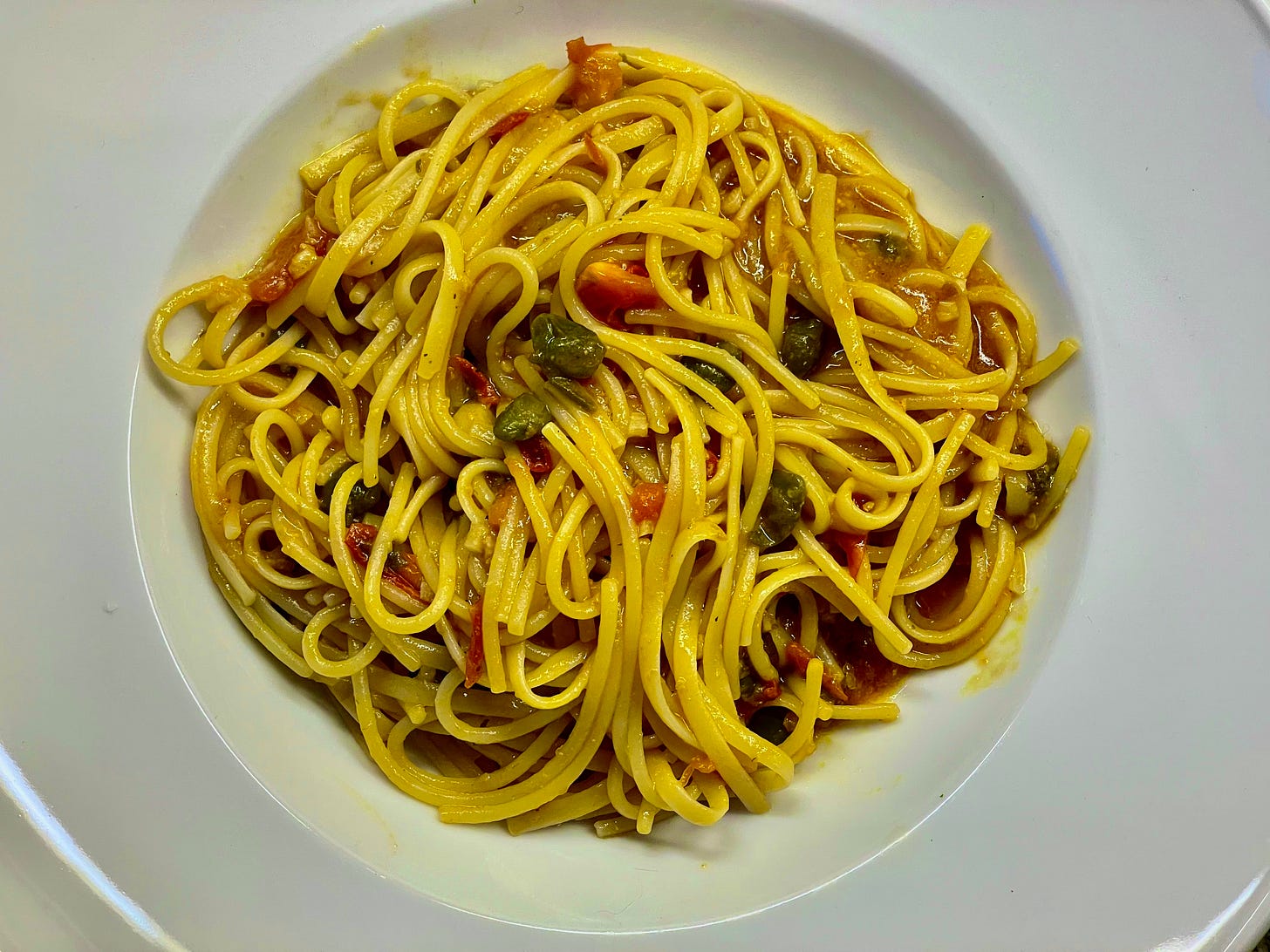Transport Your Taste Buds: A Simple Pasta Recipe That Brings Southern Italy to Your Table
How one simple pasta recipe brings the warmth and depth of Puglia and Sicily to your table, even on a cool autumn evening.


❤️ If you find this piece meaningful, consider clicking the heart at the top or bottom of the post. It helps others discover this newsletter and brightens my day.
Sitting on the balcony in mid-October, enjoying an unexpectedly warm evening, I found myself savoring the flavors of southern Italy. On my plate, a simple but layered pasta dish brought the essence of Puglia and Sicily to life. Inspired by revisiting Rick Stein’s Mediterranean Escapes, I recreated some of the region's most iconic flavors with a personal twist.
Rick Stein’s journey through Puglia introduced him to Orecchiette con cime di rapa, where the bitterness of greens meets the umami of anchovies. Sicily, on the other hand, offered him Pasta alla Norma, with its bold combination of aubergines, tomatoes, and ricotta salata. These dishes are more than just food; they’re a reflection of the land, deeply tied to seasonality and the region's heritage.
Tonight, I wasn’t physically in Italy, but the dish I prepared brought southern Italy straight to my German balcony. Spaghetti simmered in a rich tomato sauce until it had absorbed every last drop of flavor, with just the right amount of cooking water added to let the pasta soak it all in. The sauce—a blend of San Marzano tomatoes, a bit of sugar to balance acidity, capers, anchovies, garlic, and basil—created a balance of sweet, savory, and slightly spicy flavors. The half chili added a fruity heat that lingered on the palate, while the anchovies and garlic provided a rich depth. A few baby tomatoes from my balcony, chopped and mixed in fresh, added bursts of natural sweetness that complemented the bold flavors.
The result? A pasta dish that felt like a warm hug from the south of Italy, perfect for this warmer-than-usual autumn evening. The dish brought together the sweetness of the tomatoes, the sharpness of the chili, and the brininess of the capers, all harmonizing with the garlic and anchovies.
Southern Italian cooking often shines through in its simplicity—where quality ingredients and timing are everything. Whether it’s Orecchiette soaking up the flavors of bitter greens in Puglia or the Pasta alla Norma showcasing Sicily’s sun-drenched summer harvest, each dish tells a story of place, history, and seasonality. My dish, like these traditional recipes, captured the depth of the ingredients and the simplicity of the process.
The sauce itself, a combination of San Marzano tomatoes, two cloves of garlic, basil, and tomato paste, had been sitting in the fridge for two days, allowing the flavors to meld. To finish the dish, I mixed in chopped anchovies, capers, and a touch of fresh chili for heat, creating a sauce that clung to every strand of spaghetti.
This meal reminded me how food connects us to places, memories, and traditions—even when we’re miles away. It's a dish that brings the late summer of southern Italy to the table, where everything has reached its peak ripeness. Tonight, I tasted the fullness of those flavors under the German autumn sky.
Late Summer Spaghetti with Southern Italian Flavors
Serving Size 2-4 Portions
Ingredients:
250g - 500g spaghetti (2 - 4 portions)
The Raw Sauce
1 can (400g) San Marzano tomatoes or crushed tomatoes
2 cloves garlic, minced
1 tbsp tomato paste
1 branch fresh basil
The Sauce
2 cloves garlic, minced
1 tbsp capers, rinsed
1 tbsp anchovies, finely chopped
1 small fresh chili (half if you prefer less heat)
3-5 baby tomatoes, chopped
1 tbsp grated bottarga (optional)
1 tsp sugar (to taste)
Salt and pepper to taste
Olive oil for sautéing
Instructions:
Prepare the raw tomato sauce in advance:
Blend the cold San Marzano tomatoes, garlic, tomato paste, salt, and pepper into a smooth sauce. Sink a whole basil branch into the mixture and let it marinate in the fridge for at least 6 hours (or up to 2 days) to allow the flavors to develop. This sauce also doubles as a pizza base, which I explored in detail in The Perfect Pizza — A Love Letter in Dough and Sauce.
Cook the pasta:
Bring a large pot of salted water to a boil and cook the spaghetti until al dente. Reserve a cup of pasta cooking water before draining.
Cook the Sauce:
In a large pan, heat a drizzle of olive oil over medium heat. Add the finely chopped anchovies and let them melt into the oil. Stir in the raw tomato sauce you prepared earlier, along with the capers and half a chili (chopped). Quarter the baby tomatoes, take out the pulp, chop them roughly and add them to the sauce. Let the sauce simmer gently.
Combine and serve:
Gradually add about 1 cup of pasta water to the sauce, ensuring it doesn't become too watery. Drain the pasta and add it to the pan, gently stirring to coat each strand with the sauce. Cook for an additional 3–4 minutes, allowing the spaghetti to fully absorb the rich flavors. Grate over the bottarga.
Enjoy:
Enjoy the dish with some freshly grated cheese like Parmiggiano reggiano or Pecorino. This dish brings the flavors of southern Italy to your table—perfect for an autumn evening or whenever you crave Mediterranean warmth.
Optional: Let the raw sauce sit in the fridge for up to 2 days to enhance its flavors even more.
Each twist, tweak, and taste test comes with the joy of creativity—and yes, a little bit of cost, too. If this recipe resonated with you and added a touch of nostalgia or delight to your day, I’d be incredibly grateful if you’d consider leaving a tip. Or, better yet, indulge in a monthly or yearly subscription to support this publication.
Your generosity helps keep these flavors alive and ensures I can continue exploring, experimenting, and sharing them with you.
Hashtags
#LateSummerFlavors #ItalianCuisine #PugliaToSicily #PastaPerfection #SeasonalCooking #FoodInspiration #MediterraneanEats #AutumnOnAPlate #RickSteinInspired #ComfortFood






Love that you tell us to let the sauce "steep" first, to let the flavours blend and deepen ☺️. Not many recipes stress this aspect enough. Time really does work magic for sauces and stews. One reason we always make double or triple batches is that the taste gets so much more complex and intense after a day or two.